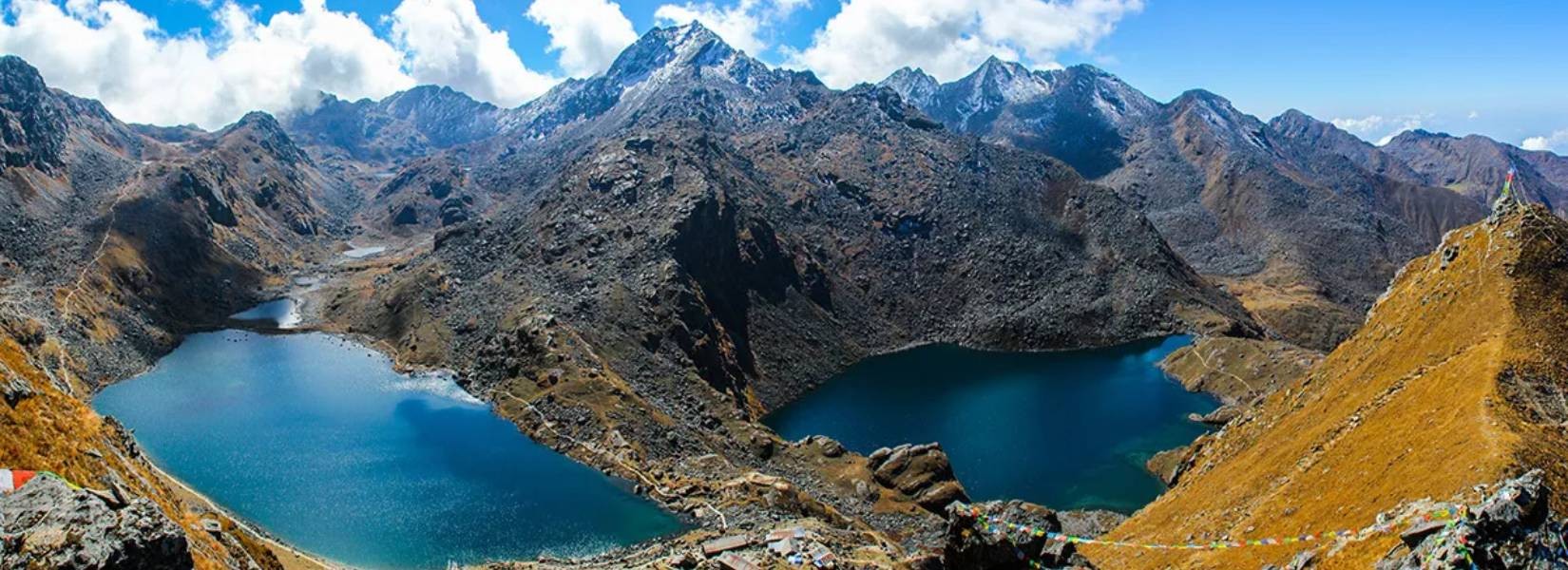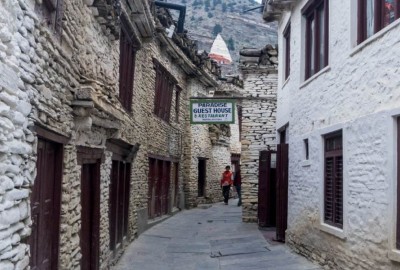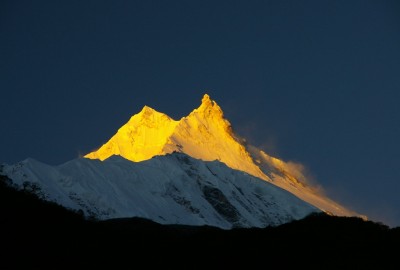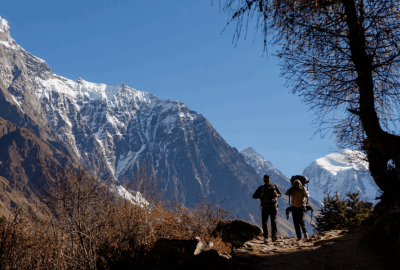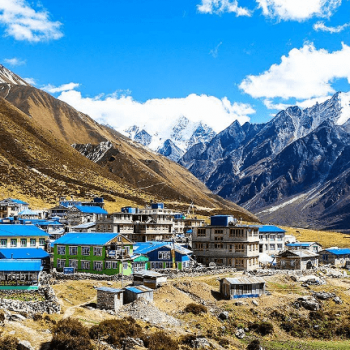Gosainkunda, visited by many tourists from all around the world as well as the people from inside the country. It is regarded as one of the most beautiful lakes that can be found in Nepal. While the Nepalese visit it mostly for religious purposes, the tourists visit it as it is a famous tourist destination.
Table of Contents
Plan your trip to Nepal
Customize your trip with help from a local travel specialist.
Located in Rasuwa district, Gosaikunda is a frozen lake situated in the Langtang National Park. With an elevation of 4,300 meters of the park, this sacred lake is situated at a high altitude and the park is bisected from south-east and east-west from the Dorje Lakpa range (6,988 meters). With a surface area covering 34 acres, the lake situated at an altitude of 4,380 meters is an alpine freshwater oligotrophic lake. Saraswatikunda, Surajkunda, and Bhairabkunda are some of the other lakes found in the area besides Gosaikunda.
The total area covered by Gosaikunda is 1,030 hectares including all of its associated lakes. On September 29 of 2017, the site was established as a Ramsar site. The Ramsar treaty is an international treaty that supports the conservation of wetlands and sustainable use. When the ice of Gosaikunda melts, it flows down to form the Trishuli River. In winter from October to June, the lake remains frozen for a period of six months. There are a total of 108 lakes in the area combining the big ones as well as the small ones. Laurebina La which is situated at an altitude of 4,610 meters is the most challenging lake.
Religious Value of Gosaikunda
The Gosaikunda area is of great importance to the Nepali culture as it is considered a religious site in Nepal. According to Hindu legend, Gosaikunda is the home of the Hindu deities Gauri and Lord Shiva. Samudra Manthan which has a direct correlation to the origin of Gosaikunda has been referenced in several Hindu scriptures like the Vishnu Puran, Ramayana, Bhagwat Puran, and the Mahabharata.
During the Janai Purnima observed by the Hindus, the water of this lake has more significance than on the other days. It is considered to be holy all year around. Thousands of pilgrims from India and Nepal visit this temple during the Janai Purnima. People also believe that Gosaikunda came into existence when Lord Shiva thrust his holy Trident (Trishul) into the mountain after he swallowed poison. He wanted to cool his burning throat so he extracted the water from the mountain.
Best Time to Visit Gosaikunda
The best time to visit Gosaikunda is from August to October or from April to early June. The monsoon and winter is not a very good time to visit the lake. Leeches will be sticking to your body because of the heavy rainfall and storms during monsoon. The path will be also difficult to trek in as the road will be muddy and slippery. As the lake is located at a higher altitude region, there will be a chance of heavy snowfall and snowstorm during winter. The chances of altitude sickness are also increased by this. So the best time to visit the lake is during the summer.
Attractions while Trekking to Gosaikunda
If you choose to Trek to Gosaikunda, here is a list of things you will see along the way:
Magnificent Mountain Views
While on the way to Gosaikunda, you will be able to see many snow-capped mountains. In the Langtang area, you will be able to see the panoramic view of the mountains and some of the Annapurna mountain range can be seen too. You will be able to see Ganesh Himal (7,422 meters), Yala (5,500 meters), Langtang Lirung (7,227 meters), Naya Kanga (5,844 meters), Paldor Peak (5,903 meters), Yobra (6,264 meters), Kinshung (6,781 meters), Langshisha Ri (6,427 meters), Changbu (6,251 meters), Ganchenpo (6,387 meters), and Dorje Lakpa (6,966 meters).
Rare Wildlife and Vegetation
As the Gosaikunda lake lies in the Langtang National Park, you might stumble upon some endangered and rare flora and fauna. Animals like Red Panda and Snow Leopard which fall on the endangered list are commonly found in the area. Himalayan Tahr, Musk deer, and leopards are some other wildlife that can be found there. The region is also famous for rhododendron, so you will find many forests with it there.
In 18 ecosystem, there are 14 types of vegetation that can be found there ranging from the upper tropical forest below 1,000 meters (3,300 feet) to perennial ice and alpine scrub. You will also find maple fir, oak, hemlock, chir and other trees. Marijuana can also be found in many parts of the forest. The people indigenous to the locality use marijuana for medicinal purposes for themselves as well as for livestock. Pain in the bones of hands or feet, acidity and stomach pain are some of the medicinal uses for marijuana according to the locals.
Villages with Unique Culture and Tradition
Along your trek, you will pass by many villages each having unique culture and tradition. Tamangs and Sherpas whose culture is influenced by the Tibetan culture are some of the tribes that have villages there. By communicating with them, you will learn why the people are so out of touch with modern infrastructures.
How to Get to Gosaikunda Lake?
Trekkers use many routes to get to Gosaikunda. The usual route followed by them starts from Dhunche or Chisapani. While both of these routes are popular, the Dhunche route is more often used. You can get a bus to get to Dhunche from Kathmandu. It is recommended to rest after the long journey by bus. You should also always carry your Trekkers Information Management System (TIMS) card.
You will trek to Cholangpaty from Dhunche which might take a whole day so it is better to stay at Chandanbarri (Singompa). Singompa is a gorgeous village which has many accommodations available. It doesn't matter which hotel you stay at. After that, you will trek to Gosaikunda. After exploring the exotic Gosaikunda lake, you will trek to Sing Gompa.
During the trek, you will be able to see the dazzling rhododendron forests and panoramic views of the mountains including Hiunchuli, Langtang Lirung, Manaslu range, Ganesh Himal and many other peaks. Your trek ends when you get to Dhunche to Sing Gompa from where you can take a bus to get back to Kathmandu.
Gosaikunda Trek Cost
The usual cost of the Gosaikunda Trek ranges from USD 450 to USD 600. The cost is mostly dependant on the number of days, the trekking routes you take, the trekking season, size of the group, accommodations and so on. As per your needs and comfort, the outline of the trek is customizable and the cost will be taken accordingly.
The cost of the trip will automatically increase if you choose to conjoin the Langtang Valley trek and the Gosaikunda trek as it adds an extra 4-5 days to the trek. It will cost around USD 650 to USD 1000 for the combined Gosaikunda and Langtang Valley trek. There will be more chances of exploration if you do the combined trek. Kyangjin Gompa and Langtang Valley are where the trek takes you first.
Then halfway across, you will return to Pairo through the same route. The trek then takes you to Gosaikunda. Along with the view of the gorgeous Gosaikunda lake, you will also get to enjoy nature and walk through grasslands, high ridge, and alpine forest. Tibetan influenced villages like the Tamang settlement and the Sherpa settlement will be passed by you along the way.
Contact us, if you need any help in planning a trip to Gosaikunda Lake.

